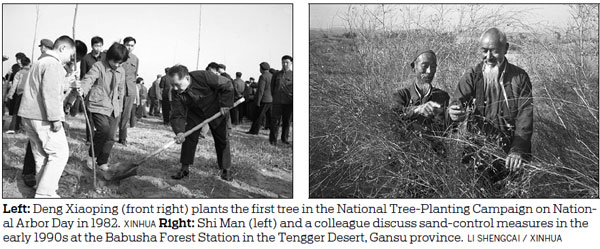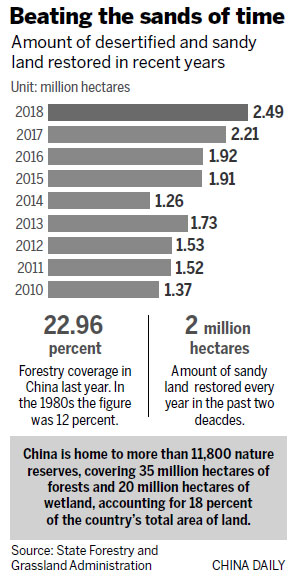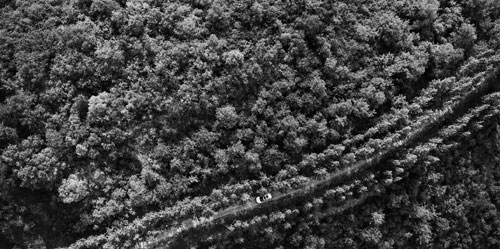Desert reclamation builds a green and pleasant land
Programs to control sand encroachment have restored the ecosystem and raised incomes. Yang Wanli reports.
Editor's note: To celebrate the 70th anniversary of the founding of the People's Republic of China, we are publishing a series of stories reflecting changes and developments in fields such as law, education, transportation and the environment. This is the sixth in the series.
A deadly sandstorm on May 5, 1993, is an unforgettable memory for Shi Yinshan, a resident of Gulang county in the northwestern province of Gansu.
Gulang used to be hit by sandstorms every three to five days on average. In most cases, the sand swept through in a few hours, leaving a thick layer across the county. However, the storm in 1993 killed 85 people, including 23 schoolchildren.
"An enormous sandstorm came suddenly, like a black wall reaching up into the sky. It moved so fast, the sky turned dark in a few minutes. We couldn't even see our hands," Shi said.
Lasting about four hours, the sandstorm killed the primary school students on their way home. Their bodies were found floating in a river they had to cross twice a day on their journey to and from lessons. In addition, 260 people were injured and 31 reported missing. Their bodies were never found.
More than 120,000 livestock were killed or went missing, and 3,700 square kilometers of farmland were buried under the sand.
Shi is a second-generation tree planter in Gulang. His father Shi Man was one of six men who "fought against the desert" in the early 1980s at the Babusha Forest Station in the south of the Tengger Desert - the fourth largest in China - which conducts forestry work designed to prevent the advance of desertification and reclaim arid land.
The disaster happened just a year after Shi Yinshan took over his father's job, shouldering the responsibility of greening the desert. The painful memory made him even more determined to pursue his mission.
"We cannot be defeated by the sand. Gulang is our home. If we do not safeguard it, who will do it for us?" he said.
Improved air quality
Typing "Gulang county" into the website of the China National Environmental Monitoring Center shows that the air quality was "good" during the first week of this month, with the average concentration of PM2.5 - airborne particulate matter that is harmful to human health - lower than 40 micrograms per cubic meter.
"The air quality has improved significantly due to the sand-control efforts in recent decades. A massive sandstorm, like the one in 1993, has not visited the county for more than 10 years," Shi Yinshan said.
According to the Gulang forestry department, in the past 38 years, rangers at Babusha have planted trees across more than 14,466 hectares, bringing 25,066 hectares of sand under control. In addition, more than 300 million trees are growing in the county, turning the previously sandstorm-ravaged region into an oasis.
The green "miracle" of Gulang is symbolic of China's efforts to green the country in recent decades. The central government has launched several programs nationwide, restricted commercial logging, protected forests and grassland, and replanted trees and grasses to reclaim desertified land.
In 1978, the Three-North Shelterbelt Program was launched to improve the environments of Northwest, North and Northeast China, while the Natural Forest Protection Program was implemented in 1998. A year later, the Conversion of Cropland to Forest and Grassland Program was launched, with the aim of minimizing widespread soil erosion and the degradation of vegetation, and improving water conservation.
Meanwhile, the National Tree-Planting Campaign - the world's longest-running public activity, initiated in 1981 - has witnessed more than 16 billion individual contributions and seen about 74.2 billion trees planted.
Soaring coverage
"Thanks to the greening efforts, China's forest coverage soared from 12 percent in the 1980s to 22.96 percent last year. By then, the country had 220 million hectares of forests, of which 80 million hectares were artificial," said Jin Min, director of the Natural Forest Protection Office at the State Forestry and Grassland Administration.
In the area of the Three-North Shelterbelt Program alone, forest coverage rose from 5 percent in 1977 to 13 percent in 2017, reclaiming 336,000 square kilometers of desertified land.

As a result of the program, the average number of sandstorm days has fallen from 6.8 per year to 2.4. Last year, the program was recognized with the "Good Practice of UNSPF" (the UN Strategic Plan for Forests 2017-2030) award by the UN Department of Economic and Social Affairs.
The rising forest coverage has driven environmental improvements. For example, the sand content of the entire Yangtze River fell by 90 percent from 2000 to 2016, and eight provinces enjoyed an average forest coverage rate of 50 percent. Fujian province took top spot with nearly 67 percent of its land covered by forests.
Wildlife has also benefited from the program, according to Li Shuming, deputy head of the State Forestry and Grassland Administration. In Hainan province, the number of Hainan gibbons - a critically endangered species - rose from just seven in 1998 to 29 last year.
Li added that the number of Wild Siberian Tigers in Northeast China has risen from 10 in 1998 to 42, while a North Chinese Leopard, a species that disappeared from surveillance records in the 1970s, was recently seen close to Beijing.
Higher incomes

As the land has gradually been covered by greenery, the improved environment, including forests and grassland, has also benefited local people through better living conditions, and green industries have provided higher incomes.
In recent years, the region of the Three-North Shelterbelt Program has become a production base for various fruits and nuts, including jujube, apples, walnuts and Chinese chestnuts, generating annual income of about 120 billion yuan ($16.8 billion) for residents.
Statistics from the State Forestry and Grassland Administration show that the revenue generated by the forestry industry reached 7.33 trillion yuan last year, and 158 million farmers have benefited from the Conversion of Cropland to Forest and Grassland Program, seeing disposable incomes rise by 14.7 percent in the past 10 years.
"Forest tours are an emerging trend with great potential. As people become more prosperous, they care more about a healthy life and want to be closer to nature," said Cheng Hong, deputy director of the administration's Forest Tourism Office.
He said forest tourism and the related health sector saw a boom last year, registering a 15 percent rise in consumers compared with 2017, bringing in revenue of about 1.5 trillion yuan.
At the Babusha Forest Station, the younger generation is exploring creative ways to generate more income by introducing new businesses to desertified land. Guo Xi, 34, the youngest ranger at the station, wants to control the sand via new methods, like planting herbs and raising pollution-free stock, such as chickens and a small number of turkeys.
Online research has allowed Guo and his colleagues to study the skills required to graft cistanche, a valuable herb that can be grown on saxaul, a tree that thrives in deserts.
"We sow the seeds of the trees and herbs at the same time. They both control desertification. And we can make extra income by selling the precious herbs," Guo said.
"Also, I've taught local residents to grow jujube and Chinese wolfberry - two popular healthy fruits that sell for high prices."
Through social media Guo learned about the rising demand for organic meat among urban residents, so he launched a trial last year in which he raised 5,000 chickens on the farm.
"The chickens eat insects and their droppings fertilize the grass and trees, which is a win-win business model in sandy areas," he said.
The chickens, priced at 100 yuan each, have brought the farm tens of thousands of yuan in extra income. However, a lack of packaging and processing facilities means they can only be sold within the county.
After Guo posted a short video of the chickens, residents of other cities and provinces messaged him to ask if they could purchase the poultry via an e-commerce platform.
"President Xi Jinping has said that lucid waters and lush mountains are invaluable assets. In recent years, we have more deeply understood the meaning of that saying, and can definitely feel the benefits that nature and the good environment are giving us," Guo said.
"I believe more young people will join our efforts to green the country and build our home into a really beautiful China."
Contact the writer at yangwanli@chinadaily.com.cn
|
|
(China Daily Global 09/25/2019 page5)



















